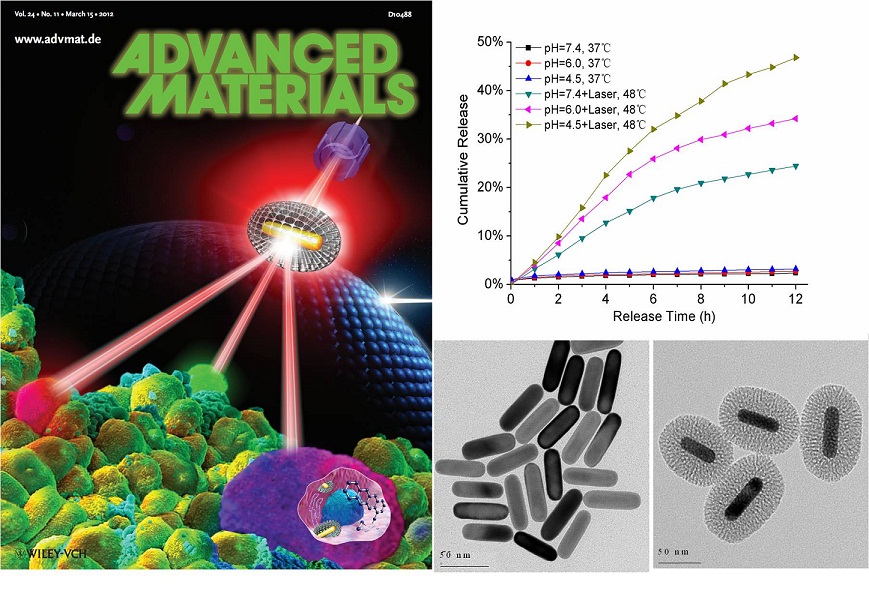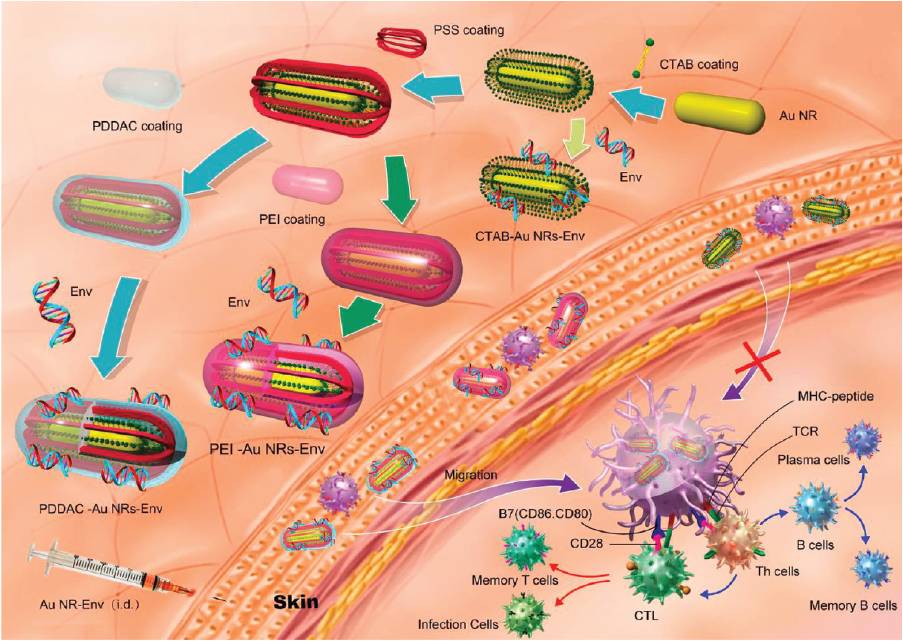1) Fullerene derivative
Fullerene derivative with different surface-coatings can inhibit the formation of angiogenesis factors, decrease the level of oxyradical in cell, increase the oxidation resistance and immunocompetence. Gd@C82(OH)22 inhibits MMP-9 mainly via an exocite interaction, whereas the well-known zinc catalytic site only plays a minimal role. Steered by nonspecific electrostatic, hydrophobic, and specific hydrogen-bonding interactions, Gd@C82(OH)22 exhibits specific binding modes near the ligand-specificity loop S1′, thereby inhibiting MMP-9 activity. Our findings provide insights for de novo design of nanomedicines for fatal diseases such as pancreatic cancer. This work has been highlighted by PNAS and EMSL. (Nano Letters, 2005; Biomaterials, 2009; ACS Nano, 2009; Carbon, 2010; PNAS, 2012 )

(PNAS, 2012)
2) Gold nanorod
We have observed that gold nanorods (NRs) have distinct effects on cell viability via killing cancer cells while posing negligible impact on normal cells and mesenchymal stem cells. We synthesize mesoporous silica-coated gold nanorods (Au@SiO2) and use two-photon imaging to determine the intracellular localization. With doxorubicin hydrochloride loaded, Au@SiO2-DOX show two light-mediated therapeutic modes: low power density laser-triggered drug release for chemotherapy, and high power density laser-induced hyperthermia.These findings thus provide guidance for the design of novel nanomedicines in tumor therapy. (Nano Letters, 2011; Advanced Materials, 2012)

(Advanced Materials, 2012)
3) Copolymer nanoparticles
We synthesized a novel hyperbranched Amphiphilic poly[(amine-ester)-co-(D,L-lactide)]/1,2-dipalmitoyl-sn-glycero-3- phosphoethanolamine copolymer (HPAE-co-PLA/DPPE) with RGD peptide (cRGDfK) and transferrin (Tf) on the periphery and used it to prepare paclitaxel-loaded nanoparticles (NPs) for dual-targeting chemotherapy. The NPs show satisfactory size distribution, high encapsulated efficiency and a pH-dependent release profile. cRGDfK and Tf decorated HPAE-co-PLA/DPPE could deliver chemotherapies specifically inside the cell via receptor-mediated endocytosis with greater efficacy. Therefore, such fluorescent nanocarrier prepared from non-cytotoxic and biodegradable polymers is promising for drug delivery in tumor therapy. (Biomaterials, 2012)
We synthesized a novel amphiphilic biodegradable co-polymer NPs, poly( L -aspartic acid- co -lactic acid) with 1,2-dipalmitoyl-sn-glycero-3-phosphoethanolamine (DPPE) (poly(AA-co-LA)/DPPE) and subsequently used it to encapsulate an antitumor drug doxorubicin (DOX). The NPs can deliver the cytotoxic drugs directly to the nucleus specifically within tumor cells. These results demonstrate the feasibility of the application of the amphiphilic polyaspartic acid derivative, poly(AA-co-LA)/DPPE, as a nanocarrier for cell nuclear delivery of potent antitumor drugs. (Small, 2012)


(Small, 2012) (Biomaterials, 2012)
4) Nano vaccine adjuvant
We use novel surface-engineered gold nanorods (NRs) as promising DNA vaccine adjuvant for HIV treatment. We have exploited the effects of surface chemistry on the adjuvant activity of the gold nanorod by placing three kinds of molecules, that is, cetyltrimethylammonium bromide (CTAB), poly(diallydimethylammonium chloride) (PDDAC), and polyethyleneimine (PEI) on the surface of the nanorod. These PDDAC- or PEI-modified Au NRs can significantly promote cellular and humoral immunity as well as T cell proliferation through activating antigen-presenting cells if compared to naked HIV-1 Env plasmid DNA treatment in vivo. These findings have shed light on the rational design of low-toxic nanomaterials as a versatile platform for vaccine nanoadjuvants/delivery systems. (Nano Letters, 2012)


(Nano Letters, 2012)
1) Fullerene derivative
Fullerene derivative with different surface-coatings can inhibit the formation of angiogenesis factors, decrease the level of oxyradical in cell, increase the oxidation resistance and immunocompetence. Gd@C82(OH)22 inhibits MMP-9 mainly via an exocite interaction, whereas the well-known zinc catalytic site only plays a minimal role. Steered by nonspecific electrostatic, hydrophobic, and specific hydrogen-bonding interactions, Gd@C82(OH)22 exhibits specific binding modes near the ligand-specificity loop S1′, thereby inhibiting MMP-9 activity. Our findings provide insights for de novo design of nanomedicines for fatal diseases such as pancreatic cancer. This work has been highlighted by PNAS and EMSL. (Nano Letters, 2005; Biomaterials, 2009; ACS Nano, 2009; Carbon, 2010; PNAS, 2012 )

(PNAS, 2012)
2) Gold nanorod
We have observed that gold nanorods (NRs) have distinct effects on cell viability via killing cancer cells while posing negligible impact on normal cells and mesenchymal stem cells. We synthesize mesoporous silica-coated gold nanorods (Au@SiO2) and use two-photon imaging to determine the intracellular localization. With doxorubicin hydrochloride loaded, Au@SiO2-DOX show two light-mediated therapeutic modes: low power density laser-triggered drug release for chemotherapy, and high power density laser-induced hyperthermia.These findings thus provide guidance for the design of novel nanomedicines in tumor therapy. (Nano Letters, 2011; Advanced Materials, 2012)

(Advanced Materials, 2012)
3) Copolymer nanoparticles
We synthesized a novel hyperbranched Amphiphilic poly[(amine-ester)-co-(D,L-lactide)]/1,2-dipalmitoyl-sn-glycero-3- phosphoethanolamine copolymer (HPAE-co-PLA/DPPE) with RGD peptide (cRGDfK) and transferrin (Tf) on the periphery and used it to prepare paclitaxel-loaded nanoparticles (NPs) for dual-targeting chemotherapy. The NPs show satisfactory size distribution, high encapsulated efficiency and a pH-dependent release profile. cRGDfK and Tf decorated HPAE-co-PLA/DPPE could deliver chemotherapies specifically inside the cell via receptor-mediated endocytosis with greater efficacy. Therefore, such fluorescent nanocarrier prepared from non-cytotoxic and biodegradable polymers is promising for drug delivery in tumor therapy. (Biomaterials, 2012)
We synthesized a novel amphiphilic biodegradable co-polymer NPs, poly( L -aspartic acid- co -lactic acid) with 1,2-dipalmitoyl-sn-glycero-3-phosphoethanolamine (DPPE) (poly(AA-co-LA)/DPPE) and subsequently used it to encapsulate an antitumor drug doxorubicin (DOX). The NPs can deliver the cytotoxic drugs directly to the nucleus specifically within tumor cells. These results demonstrate the feasibility of the application of the amphiphilic polyaspartic acid derivative, poly(AA-co-LA)/DPPE, as a nanocarrier for cell nuclear delivery of potent antitumor drugs. (Small, 2012)


(Small, 2012) (Biomaterials, 2012)
4) Nano vaccine adjuvant
We use novel surface-engineered gold nanorods (NRs) as promising DNA vaccine adjuvant for HIV treatment. We have exploited the effects of surface chemistry on the adjuvant activity of the gold nanorod by placing three kinds of molecules, that is, cetyltrimethylammonium bromide (CTAB), poly(diallydimethylammonium chloride) (PDDAC), and polyethyleneimine (PEI) on the surface of the nanorod. These PDDAC- or PEI-modified Au NRs can significantly promote cellular and humoral immunity as well as T cell proliferation through activating antigen-presenting cells if compared to naked HIV-1 Env plasmid DNA treatment in vivo. These findings have shed light on the rational design of low-toxic nanomaterials as a versatile platform for vaccine nanoadjuvants/delivery systems. (Nano Letters, 2012)


(Nano Letters, 2012)
 Close Page
Close Page- Text Size: A A A
 Printer Friendly
Printer Friendly
